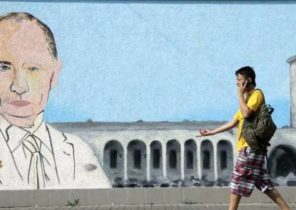“Atlantico”: a Vaccine against the disease is still not established, and many countries are worried about the appearance of the second wave of the epidemic. What does the concept of the second wave?
Stefan Gaye: the Emergence of a “second wave” really excites the minds in France since the beginning of the departure from isolation, may 11. They say also about the epidemic wave, that is, of the epidemic, which resembles a tsunami. We are talking about a monstrous wave that occurs because of an underwater volcanic eruption or earthquake. In such cases, often there is a second wave that could be even worse than the first. The same phenomenon is the second wave concerns and earthquakes on land: the second turn is worse than the first. In the military sphere, there is the concept of the “second assault”, which is also often plays a crucial role. It looks like the first wave prepares a second key. It is observed in many phenomena, both natural and not.
In addition, epidemiology is often said about second or even third wave, describing sequential and epidemic phenomenon among the population. Each year, seasonal influenza is observed first, second and sometimes the third wave.
The concept of “successive waves” probably became popular after the influenza pandemic of 1918-1919, which was developed in the framework of three consecutive waves. Compare covid-19 with the terrible pandemic, of course, not necessary, but it is possible to draw conclusions to better understand the current situation.
This historic pandemic did not originate in Spain, and (again) in Asia. Calling the virus A H1N1 was a combination of human and avian strains. He claimed at least 20 million lives worldwide, probably twice that amount. This pandemic had three phases.
The first phase or the wave was not too serious and unfolded from April to August 1918. She was very contagious and reached more than 50% of the military. Anyway, given the low severity of the disease and wartime French newspaper almost didn’t write about it: it’s been said that nothing serious is happening, that it’s just the flu.
But at the end of may 1918, Spain has been severely affected by the epidemic, primarily in the Madrid region, and its economy has witnessed a significant decline. It then emerged the concept of “Spaniard” that is not true, because Spain was its source no more than any other European country (in Spain about the virus said the most, while other European countries suffered less, but almost never mention him).
In July 1918 epidemic like beginning to subside, but the course of the disease became more severe (more frequently occurred very serious and even fatal complications in the lungs). However, in France, few people cared, because everyone thought that the French are strong enough to cope with the epidemic.
In late August 1918 epidemic has again gained strength, and very significantly, starting in the South-West and West of France.
Thus, in September 1918 launched the second wave of influenza has become very serious blow. First of all, it concerned young people (20-30 years) who have only a few days emerged, quickly leading to death pneumonia: from it perished a lot of people. The second and far more terrible epidemic wave rapidly spread to Africa and Latin America. This time all the French Newspapers wrote only about the flu. The hospital was overcrowded. Advised to isolate patients, wear masks, avoid public gatherings and enclosed spaces, where there is just a lot of people.
At the end of October — beginning of November 1918, the epidemic is slowed down. At the beginning of December 1918 was a slight increase, followed by a further decrease.
However, in February-March 1919, started a third, equally serious wave of the epidemic. They covered all continents, and the score reached 6 million deaths in India alone. In clinical terms there was unusual symptom: hair loss. Then a deadly pandemic still came to naught, leaving behind tens of millions of deaths, especially among young people.
— How real is the risk of a second wave? And looked like the 1918-1919 pandemic in the Virology plan?
— The influenza pandemic of 1918-1919 left surviving a deep impression in the minds of due to the high mortality rate, especially among young people. It spread in three waves also crashed into the memory of epidemiologists, some of which tend to shift it to the other epidemics. However, the flu virus is a very unusual virus: this RNA-containing virus, like the coronavirus, but it has one significant difference. The genome of influenza virus is segmented, i.e., consists of eight different components. It is not sustainable, can easily and often change. Every year, its genome undergoes a slight change, but from time to time there are big changes, genetic discontinuities that cause pandemics (because the result is a “new virus”, from which humans have virtually no immunity).
When the pandemic began in April of 1918, the virus was highly contagious but not particularly dangerous. Nonetheless pandemic, the picture has changed dramatically in July-August 1918. Of course, at that moment we had no biological means to understand what was happening with the virus, but scientists believe that in the summer of 1918 there was a serious mutation, genetic gap. The population lacked antibodies against the new virus, and therefore the immune system could not fight it. The older people might deal with a similar strain in the past, but the immune system of the younger generation did not possess such experience. This explains the large number of victims of the second and third waves among the youth.
— What about the coronavirus SARS-CoV-2?
— SARS-CoV-2 and all the coronaviruses in General are no different segmented RNA. Their genome is quite stable and even has a system of correction of errors during cellular replication. However, he can evolve, because it has a certain plasticity. It is worth noting that since the beginning of the pandemic covid-19 there have been several small mutations, and currently go to three different strains. Anyway, these mutations have nothing to do with recurrent genetic breaks of influenza A virus, as it was in the summer of 1918. For this reason, concerns the detrimental second wave, as was the flu pandemic of 1918, seem unjustified.
In addition, scientists believe that a large part of the population has immunity to covid-19, which was made before the beginning of the epidemic with regard to its proximity to the coronaviruses that causes coryza, rhinopharyngitis and number of acute viral gastroenteritis.
Today it is believed that from covid-19 produced by the immune system. However, in the absence of mass testing of the population it is impossible to say how many people were infected without showing severe symptoms and signs (in such cases, the person feels only slight discomfort). If a lot of people, and they have developed immunity, it should contribute to herd immunity, which should prevent a second wave. Herd immunity is a determining factor in the emergence of the second wave. It’s safe to say that in France, measures of self-isolation was observed is bad, and the virus continued to spread. Slow the spread of the virus, contributed to strengthening collective immunity.
Therefore, answering the question, I can say that the risk of a second wave of real, but the arguments against it more than for.
— Apply today the lessons from past epidemics?
Epidemic follow each other, but not similar to each other. The epidemic covid-19 little in common with the plague, cholera, typhus, smallpox, polio, meningitis. Despite all the gaps of this approach, covid-19 is the closest to a flu epidemic.
The influenza pandemic of 1918-1919 claimed a great many lives, but ended in April-may of 1919, although there were no vaccines or effective antivirals or antibiotics (against secondary bacterial infection). Hygiene was just starting to develop, and medicine has not been very effective. In addition, the First world war led to the deaths and impoverishment of the population of France. But even in such adverse conditions, the pandemic stopped, and without the use of any special methods.
Reading archival data on the pandemic of the early twentieth century, you realize that the reaction and behavior of people has not changed much. Surprisingly, many of the mistakes of those times were repeated today.
In other words, from past epidemics we can conclude, but you need to make a real effort that is not always the case, as the experience of ancestors not be used as a guide for many people. But whatever the findings, the action plan should be adapted to each outbreak. That is, a real solution can only be the vaccine.







